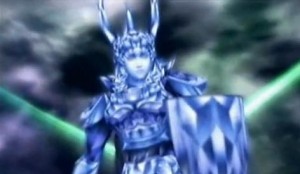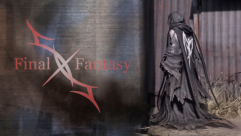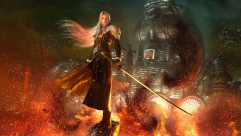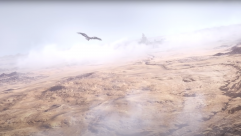Predictions and Conflict Over the Plot of Final Fantasy Dissidia 012 (Duodecim)
by Glenn, The Twilight Mexican September 27, 2010 0 comments
Well, here is my first article in quite some time, and with its publication I can verify that I’m still breathing. And with it I can also verify that I’m still very much in the business of stirring crap up, as you’ll soon see.
With the recent announcement of Dissidia Duodecim, I thought it might be a good idea to offer some predictions for where I expect the story to go, and to address some controversial elements of the overall plot that have seen a resurgence in debate since fans learned of the impending prequel. Something of a follow-up to the Dissidia Plot Analysis FAQ that MakoEyes and I wrote for the first Dissidia, this article will touch on some elements of the story discussed there, but in different detail.
Click “Read the rest of this entry” below for my thoughts on these fan debates, the overall story for this sub-series of the Final Fantasy franchise, and what we can possibly expect to see from its upcoming new entry.
There are two primary areas of ongoing debate concerning the plot of Dissidia, both of which have seen discussion on this site’s forum, as well as other venues on the Internet. The first deals with the nature of the heroes and villains featured in the story, while the second pertains to interpretations of the Cosmos and Chaos Reports (do a ctrl+f search at the linked webpage for “9.0Co” to read them) and their implications for the origins of Chaos and Cosmos, the gods of Discord and Harmony who keep the world — and apparently the entire omniverse of Final Fantasy — in balance.
That second issue for contention also ties into a third, less debated matter concerning the identity of the experimental child spoken of so much in the Cosmos Reports.

On the first matter, there are two schools of thought regarding the identities of the heroes and villains: one holds that they are the authentic individuals, as featured in the original Final Fantasy titles in which the characters first appeared; the other holds that all but the Warrior of Light and Garland are essentially advanced manikins — successful products of Cid of the Lufaine/the Great Will’s experiments involving putting disembodied souls in artificially constructed bodies.
In arguing in favor of the latter interpretation, fans point primarily to the text of Chaos Report #5:
“Harmony and discord are both created beings.
While observing how they acquired pawns to
fight in their conflict, I found that a great
number of the consciousnesses had drifted to
this world from other dimensions.
I wondered if I might be able to give those
consciousnesses physical form. After countless
experiments, finally my testing reached success.
The failures were sealed in the Interdimensional
Rift.
Within the created pawns were some whose
faith in themselved wavered–who questioned
their very reason for living. It seemed that
existence itself was not sufficient incentive.
It causes me to wonder…Were those drifting
consciousnesses remnants created in the
past? Or spirits meant to exist into the future?
This is something no one can know.”
The failures mentioned in the experiments are known to be the manikins employed in Chaos’ service in the first game, as revealed by Shantotto speaking of sealing up manikins in the Interdimensional Rift during her Distant Glory segment of the game, as well as these lines from Chaos Report #8: “It seems someone has found a use for the failed experiments I sealed into the Interdimensional Rift. These soulless pawns are used as tools of war, destroying the delicate balance between harmony and discord.”

Fans believing the FF heroes and villains of Dissidia to be the successful manikins feel that the lines “Within the created pawns were some whose faith in themselves wavered–who questioned their very reason for living. It seemed that existence itself was not sufficient incentive” points to these characters, due in part to the crises of meaning some characters undergo during Dissidia, as well as the use of the term “pawns,” which is often used in reference to the Warriors of Chaos and Warriors of Cosmos.
Fans such as myself, however, who believe the heroes and villains to be the genuine articles, feel that this line may actually be describing why the failures were, in fact, failures to begin with — as well as why they would take on the forms of others (the heroes and villains themselves, ironically enough). Notice that the above lines say “Within the created pawns,” not “Within the successful pawns.” As well, Cid refers to the manikins sealed in the Interdimensional Rift with the term “pawns” in the passage from Chaos Report #8 quoted above, so the term is not used exclusively in reference to the Warriors of Cosmos and Chaos.
Furthermore, Chaos Report #5 also states that Cid did not begin his experiments with the manikins until after witnessing “how [Chaos and Cosmos] acquired pawns to fight in their conflict.” In other words, they already had warriors and did not need Cid to create their armies for them. The opening FMV of the first Dissidia and the text that follows the cinematic also tells us that the heroes and villains of the game were part of the army of pawns the gods assembled, with those featured in the game being the few survivors:
“Cosmos, the goddess of harmony.
Chaos, the god of discord.
Reigning from distant realms,
the two gods had gathered warriors from
all lands to lead them in savage war.
Cosmos and Chaos were of equal strength.
It was believed the conflict would last forever.
But–
The balance was broken.
Those who answered Chaos’s call created an inexhaustible force.
And under vicious attack without relent, the warriors fighting for Cosmos
started to fall one by one.
The conflict that has continued for eons is now about to end in Chaos’s
favor. The world has been torn asunder, sinking into a vortex of
disorder. As for the few surviving warriors–“
[A quick note on the translation here, by the way. The line translated as “all lands” for English versions of the game was “amata no sekai” (数多の世界) in Japanese, meaning “many worlds”]
I believe it’s also noteworthy that the 2010 Tokyo Game Show trailer for Dissidia 012 includes a scene in which Kain, when confronted by several manikins in his form, declares, “You meaningless beings in human form, I will show you the strength of being human!” (translation by hitoshura). The heroes and villains of past Final Fantasy titles as the real deal would certainly seem to be the intended direction of the narrative — not to mention that scenes in the original Dissidia like Squall recovering his memories of Rinoa (“I remembered this promise I made… There’s someone waiting for me”) and Cloud giving the other heroes hope not long before Chaos was defeated (“If we can restore balance here, the other worlds will come back too. We’ll all go home, just how it was. Maybe better”) would be narratively bankrupt otherwise.
Perhaps more significantly, various passages from the Dissidia Ultimania treat the characters featured in Dissidia as the characters from prior Final Fantasy games. One straightforward example includes the book’s explanation of Cloud Strife’s line “If I win, are my sins forgiven?” (said when Cloud encounters Cloud for battle):
(pg. 530; a complete translation of the page by hitoshura can be found at TheLifestream.net’s article, “Link to the Original: Final Fantasy VII“)
“Cloud continued to regret the deaths of his best friend and comrade, who were dear to him, in FFVII.”
Another example is the book’s profile for Kuja:
(pg. 136; translation by me)
“A man born on a planet with a magical civilization, and who shouldered a mission as an ‘angel of death’ to destroy the life of another planet. He despises Zidane, who is something like his younger brother, and tries to trap him in the depths of despair. He has a tendency to get intoxicated on his own words, and is a cruel, arrogant narcissist. That said, he fears being inferior to those around him, and so his extreme pride can cause him to act impulsively and recklessly.”
[Japanese form of this paragraph:
魔法文明の星で生まれ、別の星の生命を滅ぼす゛死神゛の使命を背負った男。弟のような存在であるジタンを憎み、彼をワナにハメて絶望の淵にたたき落とそうとす る。残虐かつ 傲慢なナルシストで、自分で自分の言葉に酔いがち。雲突くほどに高いプライドを持つ反面、自分が周囲に劣るのではないかとの恐れも抱いており、ふとしたはずみ に暴走しそう なあやうさを抱える。]
Most significantly of all, however, is this line found on pg. 658, which speaks of the game’s secret ending, in which Cosmos is revealed to be alive (this translation is also by me):
“This event depicts Cosmos’s status after the warriors have returned to each world.”
[Japanese form of this line:
このイベントは、戦士たちがそれぞれの世界へ帰ったあとの、コスモスの様子を描いたもの。]
This line about the secret ending, which follows the game’s primary ending — in which Tidus, Zidane, Squall, Cloud, Terra, Bartz, Cecil, the Onion Knight and Firion all vanish one at a time — explicitly speaks of the heroes all returning to their own worlds. In other words, they are specifically identified as the authentic characters from FFII through FFX.
Despite this evidence, disagreements amongst fans continue — and are expected to until Duodecim provides further evidence to convince fans that the heroes and villains of Dissidia are the same heroes and villains seen in past installments of the Final Fantasy series.





No comments yet
Log in or Register
I like this. Very much. Keep up the good work.
So….what does the [] [] [] [] [] [] [] [] [] [] [] say?=3
nice article man….
I agree with you ,all of them are the real ones (y)
Thanks for your responses. =)
Eric: It says that you need to adjust your browser to display Japanese text. =P
wow this is cool! thanks for the… enlightenment!!! xD great info!
Bravo! I love the detail and graphical input in your thesis. What do you think about Loveless?
It seems that the game is going to be blurred between who’s going to be in the side of Chaos and Cosmos… and like in Kuja’s and Jechts case who basically got mistreated from team Chaos. The warriors of Cosmos who feel the burn of betrayal except Warrior of Light who’s in denial. Killing off Tifa and Lightning and the other so they can’t return in the next game sounds pretty cheap. Especially for Lightning because she is a true lead protagonist of a Final Fantasy game. So yeah I guess we’re all confused. I worry for both sides because it seems everyone lets their emotions run them except Squall he’s a Drone.
reply001: Thanks!
Solitaire: Thank you as well. As for Loveless, I honestly found it kind of annoying. That’s partly because most of Genesis’s lines seemed to be quotes from Loveless, and primarily because it was overly pretentious drivel.
TheMuseSway: It does sound like there will be some blurry lines here, though the first Dissidia had a bit of that as well. I disagree that killing off Tifa et al. in this game is cheap, though, as the story of the “next game” is already written and released, so it’s necessary that they die to maintain the continuity. Any future Dissidia games would presumably be based before this cycle in the war of the gods, so these new characters actually could appear again.
I love how much depth you go into with your research in these anaylsis’, the level of dedication is amazing!
Question:
If there are going to be Chaos versions of the Destiny Oddyseys then will it possibly involve the ultimate player punch where the villains each kill their respective heroes? Whilst it may not be the case for characters such as Golbez or Jecht, it would explain the whole ‘killed in the previous cycle = no memory’ situation that the Cosmos warriors suffer in Dissidia. Since Chaos is gaurenteed to win, it would be a sensible move by Square Enix to allow the player to gain victory as an antagonist so that the feeling of triumph is achieved albeit with a melancholic undertone at screwing over the guys they used to support. But then again they might feel it would be a more emotional experience for the player to fight til the bitter end ala Crisis Core and watch helplessly as their friends are felled one by one. Either way it looks like the developers want us to remember it, even if it hurts.
Interesting and insightful observations, Ella. I agree 100 percent.
Thanks for sharing your thoughts, and for your compliments.
It seems like the writer forgot the fact that CID tried to create his own manikins by imitating the process on how Chaos and Cosmos acquired their pawns. Meaning Cosmos and Chaos did the same process just as CID did only with 100% Success because they have those Godly Powers. And the realm they belong to are rich with those minerals used for creating manikins. To put it simply they are not the real heroes in physical creation, only in consciousness they are real. Plus the fact that their memories are incomplete the “GODS” just gathered what they could and used their powers to gather the minerals to create the successful manikins. Since Cid observed these events, he tried to imitate the method used by the “Gods” but was having a hard time for he LACKED power which explains he has a lot of “failures” and his success was only made possible due to careful experiment because he did not have the power of the “Gods”